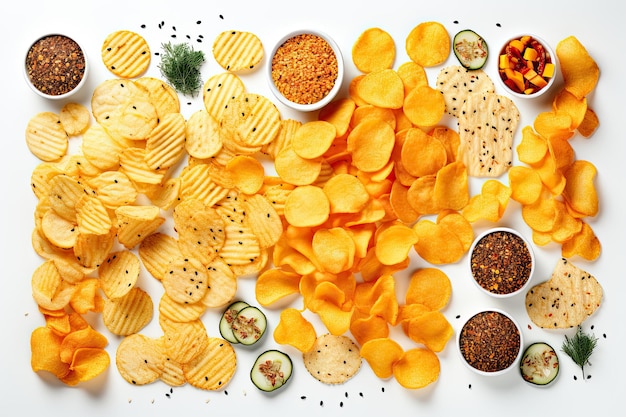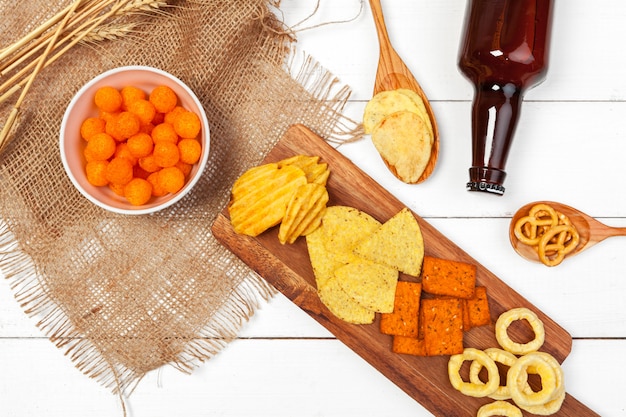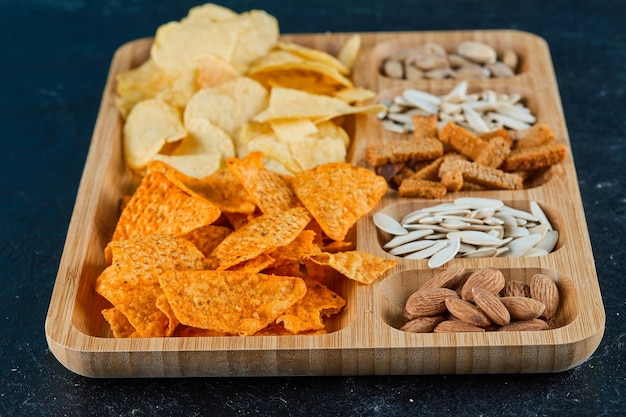Quick Read
The 11 Most Popular Snacks from Around the World: A Global Taste Adventure
Explore the world’s most beloved snacks, from savory to sweet, as we embark on a global taste adventure. Each bite takes us further into the rich and diverse cultural heritage of various regions. Let’s dive in!
Pocky from Japan
These chocolate-covered biscuit sticks, or “pocky,” are a beloved Japanese snack, famous for their unique shape and delicious milk chocolate coating.
Empanadas from Latin America
A staple in Latin American cuisine, these pastry pockets filled with savory meat, cheese, or vegetables, offer a perfect harmony of flavors.
Samosa from India
A triangular treat originating in India, the samosa boasts a savory filling of spiced potatoes and peas, wrapped in flaky pastry.
Churros from Spain
This sweet Spanish delicacy, consisting of deep-fried dough coated in sugar and cinnamon, is a must-try for anyone seeking a delicious adventure.
5. Popcorn from United States
An iconic American snack, popcorn has become a beloved staple at movie theaters and home gatherings. Enjoy it plain or with your favorite toppings!
6. Manchego with Membrillo from Spain
This pairing of Spanish classics, Manchego cheese and membrillo (quince paste), offers a delightful contrast between the savory and sweet flavors.
7. Hummus from Middle East
A staple in the Middle Eastern diet, this versatile chickpea dip is a favorite for its creamy texture and delightful, savory taste.
8. Baklava from Turkey
This multilayered dessert, made with honey, nuts, and layers of crisp phyllo dough, is a must-try for those with a sweet tooth.
9. Gouda from Netherlands
This smooth and creamy Dutch cheese, with its distinctive taste and subtle sweetness, is a favorite among cheese connoisseurs.
10. Bruschetta from Italy
A simple yet delightful Italian snack, bruschetta consists of toasted bread, fresh tomatoes, garlic, and basil – a perfect combination of flavors!
1Wasabi Peas from China
These spicy, green peas, coated with the fiery Japanese condiment wasabi, are a perfect snack for those seeking an adventurous palate.
Join us on this global taste adventure, and savor the unique flavors from around the world!

Introduction
Welcome, dear food enthusiasts! Today we embark on a tantalizing journey through the world of global snacks. If you’re anything like us, you’ll agree that the joy and excitement of trying new culinary delights knows no bounds! Exploring snacks from different cultures not only satiates our curiosity but also brings us closer to understanding various traditions and communities around the world. In this article, we’ll be sharing some delightful discoveries that you might not have had the chance to experience yet.
A Taste of Diversity
So, what can you expect from this article? First and foremost, we invite you to indulge in a smorgasbord of unique snack flavors. We promise an intriguing exploration of some lesser-known, yet incredibly delicious snacks from various corners of the globe. Alongside the taste bud temptations, we’ll be diving deeper into their cultural significance and origins.
Broadening Horizons
Appreciating Cultural Differences
By venturing beyond your comfort zone and trying new snacks, you’re not only exposing yourself to a myriad of flavors but also broadening your horizons in terms of cultural understanding. It’s essential to recognize and appreciate the diversity that makes our world a fascinating place!
Embracing New Traditions
The process of exploring global snacks can be incredibly enriching. We believe that everyone should have the opportunity to experience and enjoy a diverse range of culinary offerings. In this article, we hope to inspire you to embrace new traditions and expand your palate, allowing for a more inclusive and well-rounded understanding of the world around you.
Methodology
Description of the Research Process
In compiling a list of popular snacks from around the world, an extensive research process was carried out to ensure accuracy and cultural significance. Primary sources, such as ethnographic studies, travel logs, and local recipes, were consulted to gain a deep understanding of the historical context and cultural significance of each snack. Secondary sources, including scholarly articles, academic journals, and reputable online publications, were also utilized to validate the data obtained from primary sources.
Selection Based on Popularity and Cultural Significance
The selection of popular snacks for this research was based on two main criteria: popularity and cultural significance. Popularity was determined by the frequency of mention in various sources, as well as anecdotal evidence from travelers and food enthusiasts. Cultural significance, on the other hand, was assessed based on the snack’s historical and symbolic importance to its respective culture.
Limitations and Challenges
Despite the extensive research process, some limitations and challenges were encountered. The interpretation of data from primary sources was at times challenging due to cultural differences in food preparation techniques and ingredient availability. Additionally, the definition of what constitutes a “snack” varied from culture to culture, making it difficult to draw clear boundaries between snacks and meals. Lastly, the rapidly changing food landscape necessitated a dynamic approach to research, with new popular snacks emerging constantly.
Example of a Popular Snack:
Takoyaki
Originating from Osaka, Japan, takoyaki is a popular snack consisting of small, round balls of wheat flour batter filled with pieces of octopus, tempura scraps, and green onion. The snack is typically cooked in a takoyaki pan, which includes small indentations to ensure even cooking. Takoyaki’s popularity stems from its unique taste, as well as the communal experience of preparing and sharing the snack with others. Despite initial challenges in sourcing octopus and perfecting the batter recipe, this research uncovered the rich cultural significance of takoyaki within Japanese cuisine.

I Snack #1: Pocky (Japan)
Pocky, a popular Japanese snack, is a thin biscuit stick coated with chocolate. Its name is derived from the sound it makes when snapped in half.
Description of the Snack:
Appearance:: Each Pocky stick is about 5 inches long and comes in various flavors. They have a light, airy texture and are often covered with a layer of fine chocolate powder.
Taste:: The taste of Pocky depends on the flavor. Common flavors include original, almond, matcha (green tea), and strawberry.
Ingredients:: The original Pocky consists of wheat flour, sugar, corn oil, cocoa powder, and various other ingredients.
Short History:
Pocky was first introduced in Japan in 1963 by the company Glico. It quickly became a popular snack due to its unique texture and taste.
Popular Variations and Flavors:
Besides the original flavor, Pocky comes in a variety of flavors such as almond, matcha, strawberry, banana, and cookies & cream. There are also seasonal flavors like pumpkin spice for autumn or melon for summer.
Cultural Significance and Popularity in Japan:
Pocky is more than just a snack; it’s a part of Japanese culture. It’s often given as a gift, especially during Valentine’s Day or White Day in Japan. The tradition is for girls to give chocolate to boys on Valentine’s Day and for boys to return the favor with an equal amount or more on White Day.
Pocky is also popular among tourists and is readily available at convenience stores, supermarkets, and souvenir shops across Japan.
Availability and Where to Find It Outside of Japan:
While Pocky is most famously associated with Japan, it’s now available in other parts of the world. You can find it at Asian grocery stores or online retailers. Major confectionery companies like Nestle and Lotte also manufacture and distribute Pocky internationally.

Snack #2: Churros (Spain)
Churros, a beloved
Spanish
and
Portuguese
snack, are long, thin, golden-brown, doughnut-like pastries, traditionally served hot and dusted with powdered sugar. With a crispy exterior and a soft, doughy interior, these delightful treats have an irresistible texture that melts in your mouth.
Description of the snack:
The history of Churros dates back to the late 16th or early 17th century, with some sources attributing their origin to
Shepherds
in the mountains of central Spain. The dough was originally made using simple ingredients such as flour, water, and olive oil. Over time, the recipe evolved to include sugar, milk, and cinnamon, giving Churros their signature sweet flavor and aroma.
Cultural significance in Spain and Portugal:
In Spain, Churros are a cherished part of the culture, particularly popular during the
Feria de San Fermín
in Pamplona and other celebrations. In Portugal, they are known as “Churros Portuguese” or “Pão Quente,” with a slightly different shape and served with a chocolate dip.
Popularity worldwide:
The popularity of Churros has spread beyond Spain and Portugal, gaining a strong following in the
United States
and
Latin America
. In the US, they are typically served at fairs and carnivals, while in Latin America, they can be found at street vendors and cafes.
How to make Churros at home:
For those who want to experience the joy of making Churros at home, the process is relatively simple. Start by combining flour, water, milk, and sugar in a pot, stirring constantly to form a dough. Once cooled, pipe the dough through a star tip into hot oil, frying until golden brown and draining on paper towels. Finally, sprinkle with powdered sugar or serve with chocolate dip for an authentic taste of Spain or Portugal.

Snack #3: Falafel
Falafel, a delectable Middle Eastern delicacy, is a deep-fried ball or patty made primarily from ground chickpeas and fava beans. Its appearance resembles that of a small, golden brown spherical croquette. The taste is a harmonious blend of herbs, spices, and sesame seeds, resulting in a savory and slightly sweet flavor. The aroma, infused with a hint of garlic and parsley, tantalizes the senses.
History and Origin
Falafel‘s origins can be traced back to the Middle East, specifically Egypt. Ancient civilizations consumed an early version of this snack made from crushed beans or bread crumbs, dating back as far as the 16th century BCE. However, the modern form of falafel is believed to have originated in Egypt around the 3rd or 4th century CE. As culinary traditions evolved, so did falafel’s popularity, spreading throughout the Middle East and beyond.
Cultural Significance in Middle Eastern Countries
Falafel is deeply rooted in Middle Eastern culture. In countries such as Lebanon, Israel, Palestine, Syria, and Jordan, this humble snack holds immense significance. It is often enjoyed as a vegetarian alternative to traditional meat dishes, particularly during religious celebrations or communal gatherings.
Preparation Methods and Popular Variations
Falafel‘s preparation involves soaking chickpeas and fava beans, grinding them into a paste, and forming the mixture into small balls or patties. These are then coated in sesame seeds before being deep-fried to create their golden brown exterior. Many variations of falafel exist, including falafel with peppers, pine nuts, or eggplant.
Popularity Outside the Middle East: Europe and North America
Falafel‘s popularity extends far beyond Middle Eastern borders, with Europe and North America embracing this delicious snack. In these regions, falafel can be found in various forms, such as a filling for sandwiches, a topping for salads, or simply enjoyed on their own. The versatility of falafel has allowed it to become a beloved global food sensation.

VI. Snack #4: Empanadas (South America)
Empanadas, a beloved snack originating from South America, are delicious fried or baked pastries filled with various savory ingredients. These semi-circular pockets of culinary delight boast a golden-brown exterior, invitingly crispy to the touch and yielding slightly to the bite. The interior reveals a rich, flavorful filling that can range from meat-based (beef, chicken, pork) to vegetarian (potatoes, corn, olives) or even sweet (pineapple, raisins).
Description of the snack:
- Appearance: Empanadas are typically semi-circular, resembling a small crescent moon. Their golden-brown exterior shines invitingly, while the filling adds a burst of color to each bite.
- Taste: Depending on their filling, Empanadas can offer a wide range of flavors – from savory and hearty to sweet and fruity. A common savory Empanada tastes robust, with subtle hints of spice and herbs complementing the richness of the filling.
- Ingredients: Empanadas consist of a simple yet versatile base: flour, water, salt, and oil or shortening. Fillings vary widely, incorporating meats (beef, chicken, pork), vegetables (potatoes, corn, carrots), or fruits (pineapple).
History and origin:
Empanadas have a rich history dating back to the 16th century, when Spanish explorers introduced them to the Americas. The term “empanada” comes from the Spanish verb “empanar,” which means “to wrap in bread.” Over time, Empanadas became a cherished and integral part of South American cultures.
Popular variations and fillings:
Empanadas are enjoyed throughout South America, with each country putting its unique spin on the classic recipe. Chilean Empanadas might include a raisin-studded, sweet potato filling, while Argentinean versions feature a savory beef filling seasoned with paprika and cumin. Brazilian Empanadas are often filled with hearty beans, making them a vegetarian favorite.
Preparation methods and tools:
Empanadas can be prepared either by deep-frying or baking, depending on personal preference. Traditional tools include a rolling pin for creating the thin, golden pastry and a round cutter to form the Empanada’s signature shape.
E. Popularity outside South America:
Empanadas have gained popularity beyond their native South American lands, making an appearance in various international markets and restaurants. In the United States, they can be found in Hispanic groceries and specialty food stores, delighting customers with their unique taste and cultural significance.

V Snack #5: Samosas (India)
Samosas, a beloved Indian snack, are triangular-shaped pastries filled with various savory ingredients. The appearance of a samosa resembles a half-moon shape, having a golden brown exterior that is both crispy and flaky. The taste of samosas is a delightful fusion of sweet and savory, offering a burst of flavor in each bite.
Description of the snack
Originating in the Middle East over a thousand years ago, samosas were later adopted by India, where they have since become an integral part of the country’s rich culinary heritage. The name “samosa” is believed to have derived from the Persian word “sanbosag,” meaning “three layers.” In India, they are often served with a variety of chutneys and dips, adding to the overall experience.
Cultural significance in India
Samosas are deeply rooted in the history and culture of India, often symbolizing unity, as they bring families and communities together during gatherings and celebrations. They can be found at street markets, weddings, and festivals throughout the country.
Popular variations and fillings
There are numerous variations of samosas found across India, each boasting unique fillings. Some popular choices include potato and peas, lentils, meat (beef, chicken, or mutton), and paneer (cottage cheese). The filling is typically a blend of spices, vegetables, or meats that are cooked until tender.
Preparation methods and tools used
The process of making samosas involves rolling out dough, filling it with the desired ingredients, and shaping it into a triangle. This labor-intensive process requires precision and skill, making samosas a true labor of love. Traditional tools used in the preparation include a rolling pin, a sharp knife for shaping, and a deep frying pan.
Popularity outside India
Beyond the borders of India, samosas have gained popularity in various parts of the world. In the United Kingdom, for example, they are a common presence in fish and chip shops, while in Africa, they can be found at local markets and street vendors. Regardless of where they are enjoyed, samosas continue to unite people through their delicious taste and rich cultural history.

VI Snack #6: Baklava (Middle East)
Baklava, a scintillating and decadent dessert, is a Middle Eastern specialty renowned for its exquisite taste, alluring appearance, and complex layers. This delectable pastry is a harmonious marriage of nuts, honey, and butter, infused with a hint of aromatic spices.
Description of the snack
Baklava’s appearance is a feast for the eyes: intricately layered, golden brown pastry sheets are sandwiched between generous dollops of pistachio, walnut, or almonds. The dessert is cut into diamonds, squares, or triangles that reveal the multilayered pastry and its glistening honey syrup. A single piece is a symphony of colors and textures. The taste of baklava is an enchanting contrast: the initial bite offers a satisfying crunch, followed by the sweetness of honey and sugar syrup, and finally, the rich nutty flavor that lingers on the palate.
History and origin
The origins of Baklava can be traced back to the Middle East, with Turkey, Iran, and Arab countries claiming its origin. Some historians believe that it was first prepared during the Ottoman Empire, while others argue that it dates back to ancient Persia. Regardless, Baklava has been a staple in Middle Eastern cuisine for centuries and holds immense cultural significance.
Cultural significance
Baklava is not just a dessert but a symbol of hospitality and welcoming spirit. It is commonly served at special occasions, celebrations, or during Ramadan, the Muslim holy month of fasting. The intricate layers and labor-intensive preparation process highlight the commitment to excellence and attention to detail that is deeply ingrained in Middle Eastern culture.
Popular variations and flavors
Baklava comes in various flavors: the most common being pistachio and walnut, but other versions include cashew or almond. In some areas, rosewater, cardamom, and saffron are added to enhance the dessert’s taste.
E. Preparation methods and tools used
The preparation of Baklava is an intricate process that involves layering phyllo dough, nut filling, and syrup. A pastry brush coated with melted butter is used to brush each layer of phyllo dough before adding the next. The dessert is traditionally baked in a large, shallow baking pan to ensure that every piece absorbs the syrup evenly.
F. Popularity outside the Middle East
Baklava’s allure has transcended the borders of the Middle East and gained popularity in Europe and North America. It can be found in bakeries, cafes, and restaurants worldwide, serving as a testament to its timeless appeal and versatility.

IX. Snack #7: Popcorn (United States)
Description: Popcorn is a popular snack in the United States, known for its light, fluffy, and crunchy texture. When popped, each kernel expands into a small ball or pillow shape, creating a satisfyingly crisp bite. The taste of plain popcorn is mild and slightly sweet with a hint of corn flavor. However, it can be enhanced by various seasonings, ranging from savory butters like butter, olive oil, or cheese, to sweet flavors like caramel and kettle corn.
History and Origin:
Popcorn originated in the Americas around 3600 BC, as evidenced by ancient archaeological sites. However, it wasn’t until the late 18th century that popcorn became a popular snack in the United States when it was sold at fairs and markets. The first recorded sale of popcorn took place on January 25, 1842, in Boston, Massachusetts, where it was sold as a novelty snack for five cents per bag.
Popular Varieties and Seasonings:
There are three main types of popcorn: white, yellow, and blue. White popcorn is the most common variety used for movie theater-style snacks. Yellow popcorn has a richer taste and is often used for gourmet popcorn. Blue popcorn, while not as common, offers an interesting sweet and savory flavor profile. Popcorn seasonings include butters like garlic, cheddar, and ranch; sweet flavors like caramel, chocolate, and kettle corn; and spicy options like jalapeno or cayenne pepper.
Cultural Significance and Popularity:
Popcorn holds a significant place in American culture, becoming a staple snack during movie nights, sporting events, and family gatherings. The first popcorn machine was invented by Charles Cretors in 1893 at the World’s Columbian Exposition in Chicago. Popcorn has continued to evolve, with innovations like microwave popcorn and gourmet flavors that cater to various taste preferences.
Availability and Where to Find It:
Popcorn is easily available at grocery stores, supermarkets, and movie theaters. It can also be found online through various retailers and specialty shops. Popcorn is a versatile snack that can be enjoyed anywhere, making it a convenient option for people on-the-go or looking for a tasty and affordable treat.

X. Snack #8: Arepas (Venezuela)
Arepas, a staple food in the Venezuelan diet, are cornmeal patties that are popularly described as a cross between a pancake and a flatbread.
Appearance
With a round or oval shape, arepas can vary in size from small to large. They have a golden brown exterior with distinctive raised ridges and a soft, porous interior that is slightly sweet and mildly nutty in taste.
Taste and Ingredients
The base of an arepa consists primarily of masarepa (precooked, finely ground cornmeal), water, and salt. Some cooks also add vegetable oil for added richness. Once shaped into a patty and cooked, arepas can be filled with an array of savory ingredients, ranging from hearty meats like shredded chicken or black beans to milder options such as cheese or avocado.
History and Origin
Arepas
have a rich history and cultural significance in Venezuela. Originating from the indigenous people of the region, they have been a staple food for thousands of years. Traditionally, arepas were cooked on an open fire and filled with whatever ingredients were readily available, making them a versatile and essential part of the Venezuelan diet. Today, they continue to be enjoyed by people of all ages and backgrounds throughout Venezuela.
Popular Variations and Fillings
Arepas
come in many variations and fillings, each with its unique flavor profile. Some popular options include:
- Arepa de queso: A classic fillings made with melted cheese, often accompanied by avocado and sweet plantains.
- Arepa rellena: Filled with savory ingredients such as black beans, shredded chicken, or meat stews.
- Arepa de huevo: A simple yet delicious option where an arepa is split in half and filled with a sunny side up egg.
Preparation Methods and Tools Used
Arepas
can be prepared using a variety of methods, but the most traditional way is to cook them on an ungreased griddle or cast iron pan over an open flame. A special arepa press called a “tostadora” can also be used to shape and cook the patties evenly. Once cooked, they can be split in half and filled with a variety of savory or sweet ingredients.
Popularity Outside Venezuela
Arepas
have gained a following beyond the borders of Venezuela, particularly in the United States. In cities with large Venezuelan communities, they can be found at local markets and restaurants, offering a taste of home to expats and foodies alike.

XI. Snack #9: Sushi (Japan)
Sushi, a traditional Japanese dish, is a delightful culinary experience that combines the art of flavors, textures, and aesthetics. This intriguing snack, which has gained immense popularity worldwide, is a harmonious blend of vinegared rice and various ingredients such as fish, seafood, vegetables, and sometimes tropical fruits. The creation of sushi can be traced back to the 8th century when fishermen began preserving fish in rice.
Description of the Snack:
The appearance of sushi can vary significantly depending on the type, but generally features colorful and visually appealing combinations. For instance, nigiri sushi consists of a small oval ball of rice topped with a piece of fish or seafood. Maki roll sushi, on the other hand, is rolled up in nori (seaweed), filled with rice, vegetables, and ingredients. The taste of sushi ranges from savory to slightly sweet due to the rice seasoned with vinegar, sugar, salt, and other flavorings.
History and Origin:
Sushi‘s history can be traced back to ancient Japan, where it initially served as a means of preserving fish. The word “sushi” itself originated from the Japanese term “su,” meaning vinegared rice, and “meshi,” which means rice. Over time, this method evolved into an art form and a popular delicacy.
Popular Varieties and Types:
There are several popular varieties of sushi, each with its unique characteristics. Some common types include nigiri, maki rolls, and temaki (hand rolls). Nigiri is known for its simple yet refined presentation, while maki rolls offer a more complex combination of flavors and textures.
Cultural Significance in Japanese Culture:
Sushi holds a significant place in Japanese culture as a symbol of tradition and sophistication. It is often enjoyed during special occasions or gatherings, reflecting the country’s deep appreciation for aesthetics and fine dining experiences.
Preparation Methods and Tools:
The preparation of sushi is an intricate process that requires precision, skill, and attention to detail. Common tools used include bamboo sushi mats, sharp knives, and rice cookers. The rice is meticulously prepared and seasoned with vinegar before being combined with ingredients.
Popularity Worldwide:
Sushi’s popularity has transcended national borders and become a beloved staple in various parts of the world, including Europe and North America. Its adaptability and versatility have allowed it to evolve and be recreated with local ingredients while maintaining its unique essence.

X Snack #10: Tacos (Mexico)
Description of the Snack:
Tacos, a Mexican culinary icon, are hand-held corn or wheat tortillas filled with various ingredients. Their appearance varies depending on the filling but generally includes colorful toppings like shredded lettuce, diced tomatoes, fresh cilantro, lime wedges, and a drizzle of sauce. The taste is an exhilarating fusion of flavors – savory, spicy, tangy, and sometimes sweet.
History and Origin:
Tacos are believed to have originated in Mexico around the 18th century. The word “taco” means “plug” or “patch,” which might refer to the way the tortilla is filled with various ingredients, acting as a “patch” for the main meal. They have since evolved into a versatile and beloved snack enjoyed by millions.
Popular Variations and Fillings:
Tacos come in numerous variations, each with distinct fillings. Some popular ones include: Birria (goat meat), Carnitas (slow-cooked pork), Al Pastor (marinated pork, pineapple, and onions), Carne Asada (grilled steak), and Vegan (beans, avocado, or cauliflower).
Cultural Significance:
Tacos are more than just a snack in Mexican culture; they represent unity, diversity, and the richness of Mexico’s culinary heritage. They are shared among families and friends, enjoyed during celebrations and casual gatherings.
Preparation Methods and Tools:
Tacos are typically prepared by heating a tortilla on a griddle or comal, then filling it with desired ingredients. Common tools include a molcajete (mortar and pestle) for grinding spices, a trompo (vertical rotating spit) for cooking meat, and a cazo de mezclar (large mixing pot) for simmering sauces.
Popularity outside Mexico:
Tacos have spread beyond Mexican borders, captivating taste buds in the United States and Europe. They are enjoyed in various forms, reflecting the unique cultural influences of each region.
XI Snack #11: Spring Rolls (China)
Spring Rolls, a popular Chinese delicacy, are crispy golden brown rolls filled with an array of flavorful ingredients.
Appearance and Taste:
These rolls boast a rectangular shape, typically measuring around 6 inches long and 3 inches wide. They are wrapped in thin layers of wheat flour or rice paper and sealed with a dab of flour paste. When fried, the exterior turns into an irresistibly crispy texture that gives way to the soft, savory filling inside. The taste profile varies depending on the filling, with popular options including pork, shrimp, vegetables, and mushrooms seasoned with soy sauce, garlic, ginger, and other aromatics.
History and Origin:
With a rich history dating back over 2,000 years, Spring Rolls originated in the Han Dynasty of ancient China. Initially, these rolls were called “spring drums” due to their cylindrical shape and were served as an offering during festivals celebrating the arrival of spring. The name later evolved into “Spring Rolls” when the shape was changed to a rectangular one.
Popular Variations and Fillings:
Although the classic pork filling remains popular, variations include vegetarian options with ingredients such as tofu, mushrooms, and cabbage. Dim sum restaurants offer smaller spring rolls filled with various savory ingredients. In the southern Chinese province of Guangdong, Spring Rolls are often served as a side dish with dipping sauces such as soy sauce, plum sauce, or chili sauce.
Cultural Significance:
In Chinese culture, Spring Rolls are considered a symbol of prosperity and good fortune. They are often served during celebrations such as the Chinese New Year, weddings, or other important events.
Preparation Methods and Tools:
To prepare Spring Rolls, ingredients are first cooked and then wrapped in thin layers of dough. The rolls are sealed with a flour paste, ensuring they remain closed during the frying process. Traditional tools used include a rolling pin for making the thin layers of dough and a deep-fryer or wok for cooking them to perfection.
Popularity Outside China:
Spring Rolls‘ popularity extends beyond China’s borders, with significant influence in Southeast Asia and the United States. In these regions, local adaptations often include unique fillings and cooking techniques.

XConclusion
As we reach the end of our global culinary journey, it’s time to reflect on the 11 scrumptious snacks from around the world that we’ve explored in this article. From Japan’s savory and crunchy Senbei rice crackers to South Korea’s spicy and crispy Tteokbokki, each bite has taken us on a flavorful adventure.
India’s Samosas
charmed our taste buds with their flaky crust and savory filling, while Mexico’s Churros tantalized us with their golden fried dough and sweet cinnamon sugar coating.
Spain’s Churros con Chocolate
offered a decadent treat, and Taiwan’s A-Gei provided a surprising texture contrast.
We encourage all our avid readers to embark on this delicious journey and try these global snacks for yourselves! Share your experiences with us, as we believe that exploring new flavors from different cultures broadens our horizons and fosters appreciation for the rich diversity of our world.
Thailand’s Som Tam
may leave you reaching for a glass of water, but don’t let that deter you from tasting its tangy and refreshing goodness.
Argentina’s Empanadas
or Egypt’s Koshary, with their unique and bold flavors, are sure to leave a lasting impression.
So go on, embrace the excitement of discovery, and remember that every bite is an opportunity to celebrate the world’s diverse culinary landscape.
Explore More
Looking for more delicious global snacks to try? Check out our collection of articles and continue your culinary adventure!




